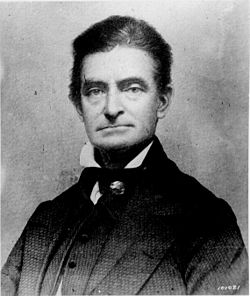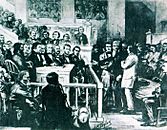Virginia v. John Brown facts for kids
Quick facts for kids Virginia v. John Brown |
|
|---|---|

|
|
| Decided | 31 October 1859 |
| Verdict | Guilty of all charges; sentenced to death by hanging |
| Charge |
|
| Prosecution | Andrew Hunter |
| Defence |
|
Virginia v. John Brown was a criminal trial held in Charles Town, Virginia, in October 1859. The abolitionist John Brown was quickly prosecuted for treason against the Commonwealth of Virginia, murder, and inciting a slave insurrection, all part of his raid on the United States federal arsenal at Harpers Ferry, Virginia. (Since 1863, both Charles Town and Harpers Ferry are in West Virginia.) He was found guilty of all charges, sentenced to death, and was executed by hanging on December 2. He was the first person executed for treason in the United States.
It was in many respects a most remarkable trial. Capital cases have been exceedingly few in the history of our country where trial and conviction have followed so quickly upon the commission of the offense. Within a fortnight from the time when Brown had struck what he believed to be a righteous blow against what he felt to be the greatest sin of the age he was a condemned felon, with only thirty days between his life and the hangman's noose.
During most of the trial Brown, unable to stand, lay on a pallet.
Contents
Background
On October 16, 1859, Brown led (counting himself) 22 armed men, 5 black and 17 white, to Harpers Ferry, an important railroad, river, and canal junction. His goal was to seize the federal arsenal there and then, using the captured arms, lead a slave insurrection across the South. Brown and his men engaged in a two-day standoff with local militia and federal troops, in which ten of his men were shot or killed, five were captured, and five escaped. Of Brown's three sons participating, Oliver and Watson were killed during the fight, Watson surviving in agony for another day. Owen escaped and later fought in the Union Army.
Reporting on the trial
Thanks to the recently-invented telegraph, Brown's trial was the first to be reported nationally. In attendance, among others, were a reporter from the New York Herald and another from The Daily Exchange of Baltimore, both of whom had been in Harpers Ferry since October 18; reports on the trial, including Brown's remarks, differ in details, showing the work of more than one hand. The coverage was so intense that reporters could dedicate whole paragraphs to the weather, and the visit of Brown's wife, the night before his execution, was the subject of lengthy articles.
The stories in the Herald were published unsigned, as the reporter, Edward Howard House, was in Charles Town incognito (in disguise), under a different name, with credentials from a Boston pro-slavery paper. He begged a visitor that knew him, Edward A. Brackett, a sketch artist from Frank Leslie's Illustrated Newspaper, not to say his real name aloud. Some of his reports, which could not be mailed safely from Charles Town, were transmitted by wrapping them around the legs of this gentleman, which were then hidden from view by his trousers.
A second artist from Frank Leslie's Illustrated Newspaper was also in attendance, and Harper's Weekly employed a local artist and nephew of Prosecuting Attorney Andrew Hunter, Porte Crayon (David Hunter Strother); one of his drawings is in the Gallery, below. Leslie informed his readers that "one of our imitators" was publishing bogus pictures. He described how his paper had engravers and artists standing by in a New York hotel, and once a sketch had arrived from Charles Town, 16 artists worked simultaneously at transforming it (split into 16 segments) into an illustration ready to be printed. The illustrations were so widely distributed that Yale Literary Magazine made fun of them, publishing the drawings of "our own artist on the spot" of "Governor Wise's shoes", "John Brown's watch", and the like.
Significance of the trial
Considering its aftermath, it was arguably the most important criminal trial in the history of the country, for it was closely related to the war that quickly followed. According to historian Karen Whitman, "The conduct of John Brown during his incarceration and trial was so strong and unwavering that slavery went on trial rather than slavery's captive."
According to Brian McGinty, the "Brown of history" was thus born in his trial. Had Brown died before his trial, he would have been "condemned as a madman and relegated to a footnote of history". Robert McGlone added that "the trial did magnify and exalt his image. But Brown's own efforts to fashion his ultimate public persona began long before the raid and culminated only in the weeks that followed his dramatic speech at his sentencing." After his arrest, Brown engaged in extensive correspondence. After the conviction and sentencing, the judge permitted him to have visitors, and in his final month alive—Virginia law required that a month elapse between sentencing and execution—he gave interviews to reporters or anyone else who wanted to talk to him. All of this was facilitated by the "just and humane" jailor of Jefferson County, Captain John Avis, who "does all for his prisoners that his duty allows him to", and had a "sincere respect" for Brown. His "humane treatment of Brown called forth the most severe criticisms from the Virginians." Brown's last meal, and the last time he saw his wife, was with the jailer's family, in their apartment at the jail.
Long-term results. The outbreak of the Civil War
"The attempt of John Brown has not had much effect, but the manner in which that attempt is received at the North is what has done the injury. The orations, speeches, sympathy, approval, the proposal to toll bells, close stores, &c., without any public manifestation to the contrary, has created a state of feeling at the South that is not to be described. ...In all our previous troubles I never had a shadow of fear as to the Union. ...But now I acknowledge that my fears amount almost to conviction that we shall see on the 5th [of December 1859] the last Congress of the present Union assemble. ...The cry for dissolution is sincere and unanimous. It is no longer the ultras and the fire-eaters."
"The execution of these prisoners is yet [1901] memorable in Virginia as one of the most impressive exhibitions ever given in the history of the State. It would have been eminently wise for the Virginia governor to have treated Brown and his followers as fanatical [insane] beyond full responsibility to the law, but the ostentatious exhibition of vengeance that came up from Virginia did much to deepen and widen the anti-slavery sentiment of the North. ...[H]e gave his life in such heroic devotion to his cause that the Northern people were impressed far beyond what they themselves had knowledge of."
Reenactment
At the time of the Civil War Centennial, at the request of the Jefferson County Civil War Centennial Committee local author Julia Davis Healy wrote The Anvil about the trial. Its first performance, in 1961, was in the same courtroom, described as "jampacked", in the Jefferson County Courthouse where the trial had taken place. There were 45 actors, most residents of Charles Town. Actual antiques were used; among other things, the man playing Brown was shackled with the handcuffs Brown had worn. Most of the words spoken were almost identical with those said at the trial. The title comes from this line in the text: "At times in history a man appears, pointed like a compass at one star—a man of iron, an anvil on which God beats out his purposes."
The trial was reenacted in 2019 by students from Shenandoah University. A version will be available at Shenandoah Valley Civil War Museum, in Winchester, Virginia.
Gallery
-
A warning to citizens of Jefferson County, Virginia, and vicinity to stay home and not attend John Brown's execution.
-
Broadside from mayor of Charles Town, Virginia, warning citizens to remain in their houses.











